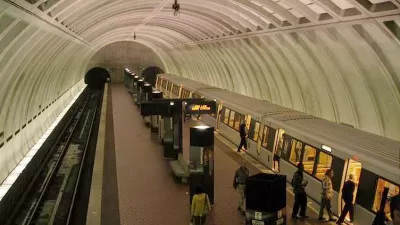This column argues that legislation to build a new stadium for Washington D.C.'s professional soccer team is also a move to jumpstart development around many of the area's transit stations.
"Included in the last-minute crush of bills that the Maryland General Assembly will consider next week is a much-reported-on piece of legislation that would provide the state's Stadium Authority with the wherewithal to further study and evaluate the economic costs, feasibility and impact of locating a professional soccer stadium for D.C. United in Prince George's County. It's important to note that the proposed legislation doesn't build a stadium. Instead, it allows for further study of the possibility of using a world-class entertainment and office venue to jump-start sorely-needed transit-oriented development at a Metro site in the county."
"The promise and the disappointment of transit-oriented development investment in the county have been addressed by outside observers such as regional economist Stephen Fuller, and local, state and regional policymakers at all levels. The proposed solution: create a sufficient density of uses and activities to generate transit ridership by encouraging, stimulating, supporting and combining private uses that will capitalize on public investment. A professional soccer stadium complex, along with ancillary offices, practice fields, public recreation amenities and opportunities for use by local school and community teams, might just provide the catalyst to kick-off private and public investment at one of the county's Metro sites."
FULL STORY: Stadium is an opportunity to score one for transit-oriented development

Alabama: Trump Terminates Settlements for Black Communities Harmed By Raw Sewage
Trump deemed the landmark civil rights agreement “illegal DEI and environmental justice policy.”

Planetizen Federal Action Tracker
A weekly monitor of how Trump’s orders and actions are impacting planners and planning in America.

The 120 Year Old Tiny Home Villages That Sheltered San Francisco’s Earthquake Refugees
More than a century ago, San Francisco mobilized to house thousands of residents displaced by the 1906 earthquake. Could their strategy offer a model for the present?

In Both Crashes and Crime, Public Transportation is Far Safer than Driving
Contrary to popular assumptions, public transportation has far lower crash and crime rates than automobile travel. For safer communities, improve and encourage transit travel.

Report: Zoning Reforms Should Complement Nashville’s Ambitious Transit Plan
Without reform, restrictive zoning codes will limit the impact of the city’s planned transit expansion and could exclude some of the residents who depend on transit the most.

Judge Orders Release of Frozen IRA, IIJA Funding
The decision is a victory for environmental groups who charged that freezing funds for critical infrastructure and disaster response programs caused “real and irreparable harm” to communities.
Urban Design for Planners 1: Software Tools
This six-course series explores essential urban design concepts using open source software and equips planners with the tools they need to participate fully in the urban design process.
Planning for Universal Design
Learn the tools for implementing Universal Design in planning regulations.
Clanton & Associates, Inc.
Jessamine County Fiscal Court
Institute for Housing and Urban Development Studies (IHS)
City of Grandview
Harvard GSD Executive Education
Toledo-Lucas County Plan Commissions
Salt Lake City
NYU Wagner Graduate School of Public Service





























